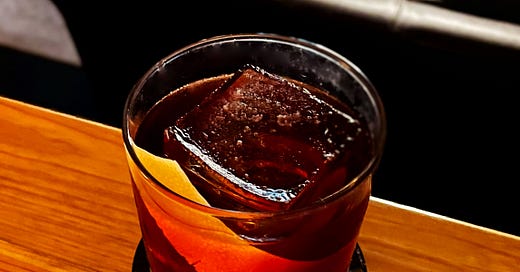It’s still Negroni Week, which means there’s still time to drink more Negronis and Negroni variations.
Over the last two decades, it is likely that no single cocktail has inspired more riffs, imitators, cousins, and potential successors than the Negroni. It’s just so easy to swap, substitute, and tweak your way to a delicious new creation. Have a new bottle of amaro? An unusual vermouth? A gin you’ve never tried before? Go ahead and Negroni away.
Negronis require no homemade ingredients, and can be made with bottles you may already have on your bar cart — or can easily procure. Many Negroni riffs are similarly user-friendly, requiring little in the way of preparation or expense. On the riffability scale, the Negroni is a perfect 10.
Of those recent riffs and variations, it is probable that the most successful is the Mezcal Negroni, which simply substitutes smoky mezcal in the slot usually reserved for gin.
The Mezcal Negroni has been a full-blown phenomenon in its own right for years, and in some quarters is obviously more popular than the gin-based original. Anecdotally, my sense is that it often serves as a gateway Negroni. I know any number of people who thought they didn’t like Negronis — until they had a Mezcal Negroni, at which point the original, gin-based drink opened up for them. The Mezcal Negroni might be a derivative concoction, but for many, it’s the first stop on the Negroni train.
These days, however, the Mezcal Negroni has a full set of dedicated tracks. Not only is the basic Mezcal Negroni a popular drink, but there are any number of Mezcal Negroni variations. Although none are as popular as the original, some are quite good, especially when they use the original formula as a platform to take the flavor profile in surprising new directions.
So as Negroni Week closes out, we’ll look back at the original Mezcal Negroni, which I have covered only briefly before, and then a variation that adds heat and vegetal bitter to the drink with an unorthodox substitution.
Yet Another Three-Part Band
I have often described classic cocktails as three-piece bands, and the Negroni is one of the cocktail world’s most successful three-piece acts.
The basic version, as you know by now, is just gin, sweet vermouth, and the Italian bitter liqueur Campari, often but not always in equal parts, typically served on the rocks with an orange peel or orange wedge for garnish.
The drink’s structure has little in common with the Daiquiri, yet it can similarly be broken down into elemental components.
In this case:
Strong: the gin
Spice & Sweet: the sweet vermouth
Bittersweet: the Campari
To make a variation, all you need to do is to fill in the strong, sweet, and bittersweet slots.
The Mezcal Negroni, then, is exactly what it sounds like: a Negroni with mezcal instead of gin, leaving the sweet vermouth in place.
This simple swap works so well, adding smoke and earthy bite to the mix, that I suspect it is one of the primary reasons for the widespread belief that any gin cocktail can be made to work with mezcal. I don’t entirely agree with that idea, but when sipping a mezcal Negroni, I can certainly see how one could entertain such a belief.
As with the classic Negroni, much of the key to the Mezcal Negroni is choosing the right vermouth.



